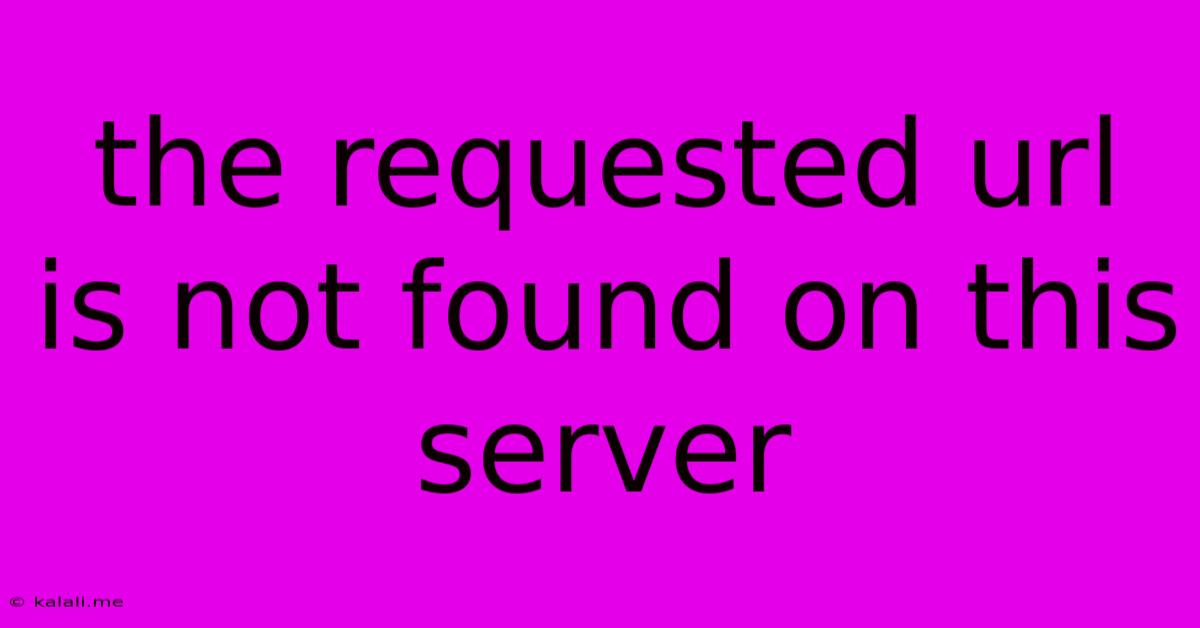The Requested Url Is Not Found On This Server
Kalali
May 22, 2025 · 3 min read

Table of Contents
The Requested URL Was Not Found on This Server: Troubleshooting and Solutions
The dreaded "404 Not Found" error – or variations like "The requested URL was not found on this server" – is a common frustration for both website owners and visitors. This error message means the web server cannot find the specific page or resource you're trying to access. This article will explore the causes of this error and provide effective troubleshooting steps for both website owners and users. Understanding this error is crucial for maintaining a smooth user experience and improving your website's SEO.
Why am I seeing this error? This frustrating message signifies a mismatch between the URL you've entered and the resources available on the server. Several factors can contribute to this:
- Incorrect URL: This is the most common reason. Typos in the website address, incorrect file names, or outdated links are frequent culprits. Double-check the URL for accuracy.
- Deleted or Moved Pages: If a page was removed from the website, but links to it still exist, visitors will encounter this error. Broken internal links, particularly after website updates, are a common source of 404 errors.
- Server-Side Issues: Problems with the web server itself, such as configuration errors or file permissions, can also prevent access to pages. This is less common but requires server administration to fix.
- Caching Issues: Your browser or network might be caching an outdated version of a webpage. Clearing your browser's cache and cookies can often resolve this.
- Broken Links: Outdated links from other websites pointing to your site can lead to 404 errors for users clicking those links.
Troubleshooting Steps for Users:
- Verify the URL: Carefully review the URL for any typos or inconsistencies. A single incorrect character can lead to a 404 error.
- Check for Similar Pages: Search the website's navigation or use the website's search bar to locate similar content. The page you are looking for might have been renamed or moved.
- Clear Your Browser Cache: Clearing your browser's cache and cookies can help resolve issues stemming from cached information.
- Try a Different Browser: Sometimes, the problem might be browser-specific. Trying a different browser can help determine if the issue lies with your browser or the website.
- Contact the Website Administrator: If the problem persists, contacting the website administrator might be necessary. They can investigate server-side issues or provide alternative links.
Troubleshooting Steps for Website Owners:
- Regularly Check for Broken Links: Implement a broken link checker tool. Many SEO tools offer this functionality, identifying and reporting broken internal and external links.
- Use 301 Redirects: If you've moved or deleted a page, implement a 301 redirect to guide users to the correct location. This preserves search engine ranking and improves user experience.
- Optimize Your Website Structure: A clear and well-organized website structure minimizes the chances of broken links. Use descriptive URLs and a logical sitemap.
- Implement a Custom 404 Page: Don't let users encounter a generic error message. Create a custom 404 page that is visually appealing and provides helpful options, such as a site search or links to popular pages. This improves user experience and reduces bounce rate.
- Monitor Server Logs: Regularly check your server logs for error messages and other issues that might be contributing to 404 errors. This helps identify and address server-side problems promptly.
Improving SEO and User Experience: A well-maintained website with minimal 404 errors is crucial for SEO. Search engines penalize sites with excessive broken links, impacting rankings. A positive user experience also relies on readily available and correctly linked content. Addressing 404 errors promptly improves both SEO and user satisfaction. By diligently following the steps outlined above, you can effectively manage and prevent these frustrating errors.
Latest Posts
Latest Posts
-
Cities Skylines Not Enough Raw Materials
May 22, 2025
-
Find Ipad Type By Serial Number
May 22, 2025
-
Will Wasps Attack At Night If You Spray Them
May 22, 2025
-
What To Put Under Vinyl Flooring In Bathroom
May 22, 2025
-
How To Remove Favourites From Safari
May 22, 2025
Related Post
Thank you for visiting our website which covers about The Requested Url Is Not Found On This Server . We hope the information provided has been useful to you. Feel free to contact us if you have any questions or need further assistance. See you next time and don't miss to bookmark.